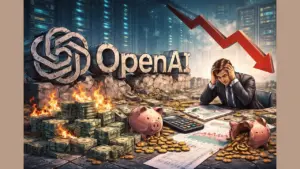Introduction
For decades, Intel stood as a symbol of innovation in the semiconductor industry. Its chips powered personal computers worldwide, making the brand synonymous with cutting-edge performance. However, the tech landscape moves fast, and even giants can stumble. Intel’s recent challenges—massive layoffs, delayed projects, leadership shifts, and missed technological waves—have raised concerns about its future.
The company now faces a battle to reclaim its position as competitors surge ahead. Is Intel on the brink of reinvention or decline? Understanding its story offers lessons for every business, from startups to global enterprises.
1. Missed Waves: How Mobile and AI Slipped Away
When smartphones began dominating the market in the late 2000s, Intel focused heavily on maintaining its stronghold in PC chips. While that seemed safe, it meant ignoring the next big thing. Qualcomm, ARM, and Apple capitalized on the mobile wave, leaving Intel struggling to catch up.
Intel’s attempts to enter the smartphone processor market came too late and lacked the performance-per-watt advantage that ARM-based designs offered. Even when it partnered with manufacturers, the momentum had shifted.
The story repeated itself with artificial intelligence. As AI reshaped computing, NVIDIA’s GPUs became the gold standard for AI workloads. Intel invested in AI eventually, acquiring companies like Habana Labs, but the delay cost it a chance to dominate a rapidly expanding sector. In tech, being second often means being irrelevant.
Lesson: Spotting trends early isn’t enough. Acting on them quickly is what keeps a company competitive. A Fractional CTO would likely highlight Intel’s hesitation as a case study in missed timing.
2. Strategic Missteps: Playing It Too Safe at the Wrong Time
Intel’s over-reliance on PC sales created a comfort zone that proved costly. While other chipmakers diversified into mobile, cloud, and custom silicon, Intel doubled down on what worked in the past.
Manufacturing delays added to the problem. The company struggled to transition to advanced nodes, while rivals like TSMC and AMD surged ahead with 7nm and 5nm technologies. These setbacks eroded Intel’s performance advantage, once its strongest selling point.
Failed expansions and underwhelming acquisitions also hurt Intel’s momentum. While it bought several promising startups, integration issues and unclear strategies meant the value wasn’t fully realized.
For businesses, Intel’s story reinforces a core truth: past success can blind you to future risks. A Fractional CTO reviewing these decisions would emphasize the need for agility, diversified investment, and constant reassessment of core markets.
3. Leadership Turbulence and Its Ripple Effect
Leadership stability plays a critical role in shaping company vision. Intel has had multiple CEO transitions in a relatively short span. Each brought a different strategy, forcing employees to adjust direction repeatedly.
This instability disrupted product roadmaps, slowed innovation, and caused internal misalignment. Engineers and managers working under uncertain leadership often lack clarity on long-term goals, which can delay crucial projects.
In tech, where development cycles are measured in years, these disruptions are costly. Competitors with steady leadership have used this time to tighten their market positions.
Lesson: Leadership changes should be strategic, not reactive. Consistent vision and execution are as important as technological innovation.
4. Layoffs: A Sign of Structural Weakness
Intel’s workforce reductions are not minor corrections. They are some of the largest in the industry—five times higher than competitors in some cases. Entire product teams have been disbanded, and projects with potential have been scrapped.
These layoffs send a clear message: Intel is not just trimming costs; it is restructuring in response to years of misaligned priorities. But such large-scale reductions have side effects. Losing experienced engineers and designers means losing institutional knowledge and innovation capability.
For a company dependent on cutting-edge research and manufacturing, the departure of key talent can create long-term damage. Retaining skilled employees during turbulent times requires strong communication and trust, something Intel must work hard to rebuild.
5. ARM’s Rise and Intel’s Struggle to Catch Up
ARM-based processors have reshaped computing. They offer high efficiency, low power consumption, and scalability across devices. While ARM powered most mobile devices, companies like Apple proved its potential in desktops and laptops with their M-series chips.
Intel’s x86 architecture, once dominant, suddenly looked outdated for emerging computing needs. ARM’s ability to deliver performance with efficiency exposed Intel’s slow adaptability.
To counter, Intel is investing in new architectures and partnerships, but reversing the momentum of an entire industry is no easy feat. The longer it takes, the more entrenched ARM becomes in markets Intel once controlled.
A Fractional CTO would view Intel’s underestimation of ARM as a pivotal mistake. Recognizing disruptive technologies early and preparing for their impact is vital for survival.
6. Cultural and Operational Challenges
Intel’s internal culture has also faced scrutiny. As the company grew, bureaucracy slowed decision-making. Innovation thrives on agility, but layers of management often delayed crucial product decisions.
Operationally, Intel’s manufacturing arm, once its greatest strength, struggled to maintain its edge. Supply chain issues and technical delays further hindered progress, creating a gap competitors exploited.
For tech companies, balancing scale with speed is one of the hardest challenges. Intel’s experience underscores the importance of fostering a culture that can evolve as fast as the market.
7. Lessons Businesses Can Learn from Intel’s Crisis
A. Speed and Timing Define Market Leaders
Responding quickly to emerging trends separates leaders from laggards. Intel’s delayed moves in mobile and AI show how hesitation can cost billions.
B. Stable Leadership Is a Competitive Advantage
Consistency at the top creates confidence throughout the organization. Frequent leadership shifts create confusion and slow execution.
C. Diversify Before the Market Forces You
Relying too much on a single product line or market segment increases risk. Diversification must happen proactively, not reactively.
D. Innovation Requires Investment and Boldness
Cutting costs at the expense of R&D can kill long-term competitiveness. Intel’s delayed manufacturing advancements allowed rivals to set the pace.
E. Culture Can Make or Break Tech Giants
An innovative culture must balance process with creativity. Large organizations must avoid letting bureaucracy suffocate progress.

8. Can Intel Recover?
Intel isn’t finished yet. It still holds significant market share, brand recognition, and resources. The company is investing heavily in catching up on manufacturing technology, entering new markets, and regaining leadership in AI and server chips.
However, recovery will require more than money. It demands a cultural reset, stable leadership, and the ability to take risks. Intel must also accept that the industry has changed. Competing with ARM and NVIDIA means embracing new architectures and business models.
The next five years will determine whether Intel stages a comeback or continues to lose ground.
Conclusion
Intel’s story is not just about chips—it’s about leadership, culture, and timing. From missing the mobile and AI booms to underestimating ARM and facing massive layoffs, the company’s journey offers lessons for businesses of all sizes.
For startups, the takeaway is clear: innovation doesn’t wait. Agility and foresight are essential to survive in fast-moving industries. For established enterprises, Intel shows the dangers of complacency and the need for constant reinvention.
At StartupHakk, we emphasize that no company—no matter how dominant—is immune to disruption. Intel’s challenges are a reminder that staying ahead requires vision, adaptability, and the courage to evolve. Whether Intel becomes a comeback story or a cautionary tale depends on how it acts today.




